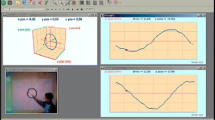Abstract
In this paper, we explore the relationship between learners' actions, visualisations and the means by which these are articulated. We describe a microworld, Mathsticks, designed to help students construct mathematical meanings by forging links between the rhythms of their actions and the visual and corresponding symbolic representations they developed. Through a case study of two students interacting with Mathsticks, we illustrate a view of mathematics learning which places at its core the medium of expression, and the building of connections between different mathematisations rather than ascending to hierarchies of decontextualisation.
Similar content being viewed by others
REFERENCES
Arzarello, F.: 1991, ‘Pre-algebraic problem solving’, Paper presented at a seminar on problem-solving, Viana do Castelo, Portugal.
Balacheff, N.: 1986, ‘Cognitive versus situational analysis of problem-solving behaviours’, For the Learning of Mathematics 6(3), pp. 10–12.
Balomenos, R., Ferrini-Mundy, J. and Dick, T.: 1988, ‘Geometry for calculus readiness’, Lindquist, M., and Schulte, A. (Eds.), Learning and Teaching Geometry, K-12, pp. 185–209. Reston, VA: NCTM.
Confrey, J.: 1993, ‘The role of technology in reconceptualizing functions and algebra.’ Becker, J., & Pence, B. (Eds.), North American Chapter of the International Group for the Psychology of Mathematics Education, California, USA, pp. 47–74.
Department of Education and Science: 1991, Mathematics in the National Cirriculum. HMSO.
diSessa, A.: 1995, ‘The many faces of a computational medium: Teaching the mathematics of motion’, in A. diSessa, C. Hoyles, & R. Noss (Eds.), Computers for Exploratory Learning, Springer-Verlag, Berlin.
Dreyfus, T.: 1990, ‘Advanced mathematical thinking’, Nesher, P., & Kilpatrick, J. (Eds.), Mathematics and Cognition, Cambridge University Press, Cambridge.
Dreyfus, T.: 1993, ‘Didactic design of computer-based learning environments’, Keitel, C., & Ruthven, K. (Eds), Learning from Computers: Mathematics Education and Technology, pp. 100–130.
Eisenberg, T. and Dreyfus, T.: 1991, ‘On the reluctance to visualize in mathematics’, Zimmermann, W., & Cunningham, S. (Eds.), Visualization in Teaching and Learning Mathematics, Mathematical Association of America, Providence, RI, pp. 25–38.
Goldenberg, E. P.: 1991, ‘The difference between graphing software and educational graphing software’, in Zimmermann, W., & Cunningham, S. (Eds.), Visualization in Teaching and Learning Mathematics, Providence, RI, Washington DC, pp. 77–86.
Hadamard, J.: 1945, The Psychology of Invention in the Mathematical Field, Princeton University Press.
Healy, L. and Hoyles, C.: 1997, Linking Visual and Symbolic Approaches to Algebra: the Influence of Task Design.
Hillel, J. and Kieran, C.: 1987, ‘Schemas used by 12-year-olds in solving selected turtle geometry tasks’, Recherches en Didactique des Mathématiques 8(1.2) pp. 61–102.
Hillel, J., Kieran, C. and Gurtner, J. L.: 1989, ‘Solving structured geometric tasks on the computer: The role of feedback in generating strategies’, Educational Studies in Mathematics 20, pp. 1–39.
Hoyles, C.: 1987, ‘Tools for learning: Insights for the mathematics educator from a Logo programming environment’, For the Learning of Mathematics 7(2), 32–37.
Hoyles, C. and Sutherland R.: 1989, Logo Mathematics in the Classroom, Routledge, London.
Kaput, J.: 1986, ‘Information technology and mathematics: Opening new representational windows’, Journal of Mathematical Behavior 5, 187–207.
Kaput, J. J.: 1989, ‘Linking representations in the symbol systems of algebra’, Wagner, S. & Kieran, C. (Eds.), Research Issues in the Learning and Teaching of Algebra, Lawrence Erlbaum, Hillsdale, NJ.
Kaput, J.: 1995, ‘Overcoming physicality and the eternal present: Cybernetic manipulatives’, in R. Sutherland & J. Mason (Eds.), Exploiting Mental Imagery with Computers in Mathematics Education, Springer Verlag, New York, NY.
Lee, L., and Wheeler, D. H.: 1987, Algebraic Thinking in High School Students: Their Conceptions of Generalisation and Justification, Concordia University, Montreal.
MacGregor, M. and Stacey, K.: 1992, ‘Seeing a pattern and writing a rule’, Proceedings of the Sixteenth International Conference for the Psychology of Mathematics Education, pp. 181–188. New Hampshire: Program Committee of the 16th PME Conference.
Noss, R. and Hoyles, C.: 1996a, ‘The visibility of meanings: Designing for understanding the mathematics of banking’, International Journal of Computers for Mathematical Learning 1(1), 3–31.
Noss, R. and Hoyles, C.: 1996b, Windows on Mathematical Meanings, Dordrecht, Kluwer.
Noss, R. and Hoyles, C.: 1992, ‘Looking back and looking forward’, Hoyles, C., & Noss, R. (Eds.), Learning Mathematics and Logo, MIT Press, Cambridge, Massachusetts, pp. 431–468.
Noss, R.: 1997, ‘On static and dynamic algebra systems’, in: Kaput, J. (in press). Early Algebra., SUNY Press, New York.
Orton, A. and Orton, J.: 1994, ‘Students' perception and use of pattern and generalization’, Da Ponte, J. P., & Matos, J. F. (Eds.), Proceedings of the Eighteenth International Conference for the Psychology of Mathematics Education, Program Committee of the 18th PME Conference, University of Lisbon, Portugal.
Papert, S.: 1972, ‘Teaching children to be mathematicians versus teaching about mathematics’, International Journal of Mathematical Education in Science and Technology 3, 249–262.
Presmeg, N. C.: 1986, ‘Visualisation in high school mathematics’, For the Learning of Mathematics 6(3), 42–46.
Stacey, K.: 1989, ‘Finding and using patterns in linear generalising problems’, Educational Studies in Mathematics 20, 147–164.
Weir, S.: 1987, Cultivating Minds: A Logo Casebook, Harper & Row, London.
Wilensky, U.: 1991, ‘Abstract meditations on the concrete and concrete implications for mathematics education’, Harel, I., & Papert, S. (Eds.), Constructionism, Ablex Publishing Corporation, Norwood, NJ, pp. 193–204.
Author information
Authors and Affiliations
Rights and permissions
About this article
Cite this article
Noss, R., Healy, L. & Hoyles, C. The Construction of Mathematical Meanings: Connecting the Visual with the Symbolic. Educational Studies in Mathematics 33, 203–233 (1997). https://doi.org/10.1023/A:1002943821419
Issue Date:
DOI: https://doi.org/10.1023/A:1002943821419




